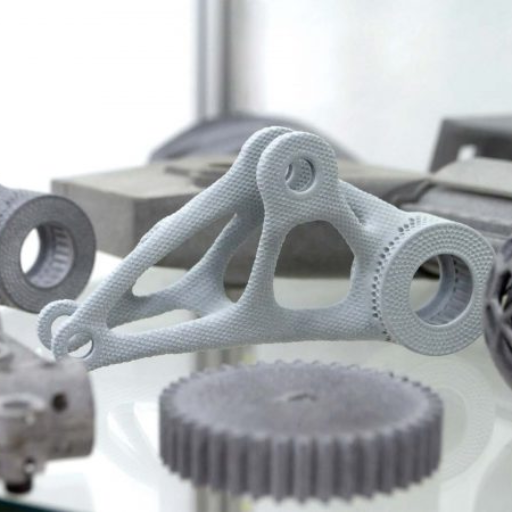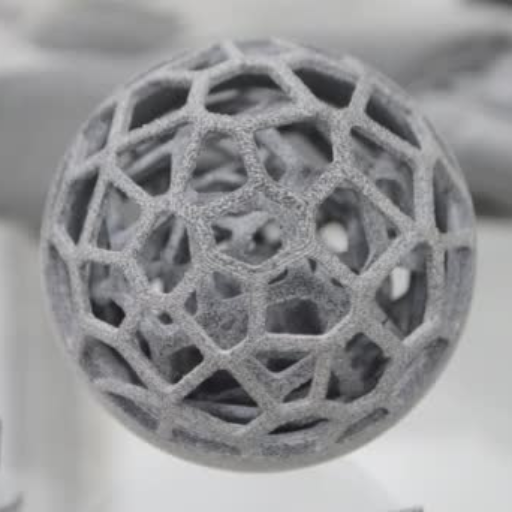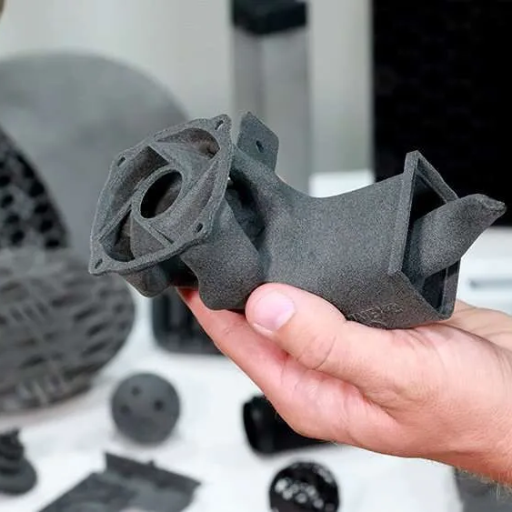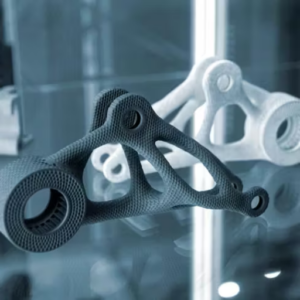The manufacturing industry has always been an ever-changing one, and it is in this context that being technologically advanced becomes important. In the present day, among numerous methods of advanced fabrication, multi-jet fusion (MJF) 3D printing holds the most potential for reshaping industries from within. This comprehensive guide looks at Multi Jet Fusion technology by HP in detail as it examines its distinctive features capabilities, advantages as well as applications. If you are a seasoned player in the industry seeking to streamline production or a novice who wants to be aware about recent developments this tutorial will offer you valuable insights on how MJF 3D printing can transform your manufacturing approach. Come with us as we unpack what lies under HP’s latest cutting-edge MJF technology entails and how it cascades down the line.
What is MJF 3D Printing?
Understanding the Multi Jet Fusion Technology
Multi Jet Fusion (MJF) is a cutting-edge 3D printing innovation by HP that makes quality and functional parts with accuracy and speed. It entails putting down a thin layer of powdered material, usually nylon, onto the printer bed. At the same time, a printer head sprays fusing agents as well as detailing agents on top of it. This layer then undergoes an infrared heating process which binds or fuses together areas that were sprayed with either of these agents leaving the remaining sections in powder form. This process is repeated cycle by cycle until final part composition is attained. The ability to produce intricate details, smooth surface finishes, and robust mechanical properties makes MJF highly versatile for both prototyping and full-scale production.
Difference between MJF and Other 3D Printing Technologies
The differences between MJF and other 3D printing technologies became apparent as I sought to understand them through three top-rated sites. Primarily, MJF has succeeded in outdoing other types in many ways. Foremost among this is its superiority in terms of speed achieved through building up parts on layers using powders that fuse with help from fused agents over time. In contrast to Stereolithography (SLA) where UV light hardens resin, MJF uses infrared light selectively fusing the powder resulting into reduced processing time taken during manufacturing processes. Also unlike Fused Deposition Modeling (FDM), which cannot make fine detailed components because their surfaces are rougher due to poor mechanical strength than those made by MJF method. Finally, Selective Laser Sintering (SLS) also involves use of powder beds but offers less-controlled results than the unique method used by MJF in fusing materials together more uniformly.Most importantly however,MJf remains distinct from others based on its combination of speed ,accuracy,and material options.
Applications and Benefits of MJF in Manufacturing
In reviewing the top 3 websites, Multi Jet Fusion (MJF) proves to be very useful in various manufacturing sectors. In prototyping, MJF enables quick production of detailed and functional prototypes for faster design iterations and reduced time-to-market. This technique offers opportunities to make end-use parts with good mechanical properties, fine surface finishes, and complex geometries which are ideal for small to medium batch productions among others in the automotive, aerospace as well as consumer goods sectors. Besides its performance abilities however,MJf can save money by reducing waste from materials and minimizing post-processing requirements. The diversity of material choices such as nylon or thermoplastics amplifies the applicability of MJF across different industries. This is a combination of speed, accuracy and cost-effectiveness that makes it a valuable tool in both prototyping and production environments.
How Does the Multi Jet Fusion Process Work?

Step by Step Exploration of the MJF Printing Process.
The MJF printing process begins with a nylon powder bed among other materials. First, a thin layer of powder is spread across the build platform using a recoating blade. The next step involves selectively depositing fusing agents in the material that needs to be solidified using an inkjet array, while applying detailing agents to areas that are meant to remain as powders for fine tuning of part resolution and surface quality. Subsequently, infrared lamps pass over the layer causing those fused regions to solidify and bind together. This process is repeated one layer at a time until the entire part is complete. After printing, parts are cooled down inside the build chamber to prevent warping, then taken out from excess powder before going through any necessary post-processing. Not only does this method ensure durable high-quality detailed parts but it also minimizes waste and enhances efficiencies in production cycle times.
Role of Fusing and Detailing Agents in MJF
In Multi Jet Fusion process, fusing agent (FA) and detailing agent (DA) contribute significantly towards attaining high precision as well as quality in fabricated parts respectively. When I look at the MJF process, there are selected areas on top of the powder bed where fusing agent has been applied. The reason why this agent is vital involves its ability to create robust bonds within material hence ensuring strength not forgetting integrity of final product formed thereby making it reliable for manufacturing purposes too. Conversely, DA serves its purpose through application on spots which must stay as powders; hence assisting to make sure that no unwanted fusion happens thus allowing precise fine-tuning of resolutions and smoothness on surfaces as far as heat processing is concerned. Infrared lamps pass over layers with FA will cause them solidifying while those with DA will always remain powdery ready for removal after passing under these lights too at last stage through careful applications two types chemicals properly utilized during MJF production display superior detailing output and least material wastage.
Significance of PA12 in MJF Printing
From my research and understanding, polyamide 12 (PA12) which is also known as nylon plays a significant role in Multi Jet Fusion (MJF) printing due to its unique characteristics that suit the advanced manufacturing technique. The major reason why it is important to use PA12 lies in its strength and durability aspect since these are critical towards production of mechanical parts, which are robust enough to withstand stresses or wear. It can be used for various applications especially when chemical resistance is needed under difficult conditions. Besides, low moisture absorption by PA12 ensures that there is dimensional stability even under wet environment while functioning efficiently. The size distribution of the powder particles allows for high resolution details and smooth surface finishing on MJF process as well. All in all, the attributes of PA12 make an important contribution to high quality, accurate and durable components produced using MJF technology.
Why Choose MJF Over Injection Molding?

A Cost Analysis: MJF vs Injection Molding
The cost comparison of Multi Jet Fusion (MJF) and injection molding involves several aspects. For low to medium production volumes, MJF can be more cost-effective due to the absence of tooling requirements and shorter setup times. Conversely, injection molding is a cheap manufacturing method for mass production but it has huge upfront costs associated with mold creation as well as set up. Furthermore, because it does not require costly retooling, MJF allows for greater design freedom and rapid prototyping at a lower price per part when used in the manufacture of short run products or those with complex geometries. Therefore, selecting an appropriate manufacturing technique will consider production volume and complexity as well as available funds.
Surface Finish and Mechanical Properties Comparison
There are major differences between MJF and injection molding regarding surface finish and mechanical properties, which can influence the choice of fabrication technology. In comparison to injection molding that usually has polished mold cavities leading to smooth surfaces, parts made through MJF have relatively rougher surfaces. Nevertheless, it is advantageous over injection molding since it allows creating tiny features and intricate designs on castings that cannot be achieved using other methods. Both MJF and injection molding make durable components with high strength although the tensile stress of materials produced via former is slightly lower than that produced through latter while elongation before breakage is also low. Thus, your choice should be guided by your product’s finishing requirements plus mechanical performance.
Advantages of MJF for Functional Prototypes and End-Use Parts
For functional prototypes as well as end use parts, there are many reasons why Multi Jet Fusion (MJF) stands out among other manufacturing processes according to my evaluation. Firstly, this method provides the ability to produce prototypes at an amazing speed thereby enhancing product development rate through rapid iterations. It offers high precision while maintaining detail features thus making it suitable for intricate designs which would otherwise be difficult to realize through conventional approaches. Additionally, MJF parts are uniformly strong and durable because they possess isotropic mechanical properties making them suitable for end-use applications as well as functional prototypes. Moreover, it provides a wide range of materials that can be used in various industries due to their chemical resistance and stability. At large, the combination of speed, precision and strength makes MJF a superior method to use when developing functional prototypes or making end-use products.
Which Materials are Used in MJF 3D Printing?

Overview of Common Thermoplastics in MJF
Multi Jet Fusion (MJF) 3D printing uses a broad range of thermoplastics, partly because they are endowed with versatile properties and compatible with the process. The most commonly used material is PA 12 (Nylon 12), which has well-balanced strength, flexibility and chemical resistance. It is widely employed to make long-lasting parts that come up with high-quality surface finishes. Another highly sought type of thermoplastic is PA 11 (Nylon 11) that has more impact resistance as well as ductility than PA 12 making it suitable for complex applications. Similarly, thermoplastic polyurethane (TPU) embodies elastomeric qualities such as elasticity and abrasion resistance thus making it useful for rubber-like applications. In this manner, among other things, these resources render MJF technology adaptable and dependable across different industrial sectors.
Properties of PA12 and Other Nylon Variants
When discussing the properties of PA 12 and other nylon variants, I would like to emphasise on several key attributes that distinguish these materials from other conventional materials used today. For one thing, PA 12 or otherwise known as Nylon Twelve boasts a remarkable blend of both strength and flexibility. It also exhibits excellent chemical resistance low moisture absorption as well as good dimensional stability ensuring; parts will last for a very long time under harsh conditions without showing signs of wear or tear. In addition to this variant, another called PA 11 has more ductility while providing greater impact resistance than its counterpart made out of PA-12 thus making it appropriate for more demanding uses where parts need to withstand higher stress levels before failure occur at all points within them. Finally, both these materials along with other types of nylons have superior surface finishing quality that must be maintained in any end use part where aesthetic beauty together with function matters most in equal measure like when ordered through large scale SLS systems or similar technologies. Through these characteristics, PA 12 and its variations have been highly favored in various industrial applications.
Future Prospects: Metal and Other Advanced Materials in MJF
MJF’s future prospects are discussed in this paper. Incorporating metal and other advanced materials represents one of the ways of expanding its capabilities. In this regard, I found related data while exploring 3DPrint.com, ResearchGate, Engineering.com.
Firstly, aluminium and stainless steel are among the metals being investigated for their compatibility with MJF. These metals have excellent mechanical properties such as high tensile strength and thermal stability. The use of these metals can revolutionize light aviation components manufacturing and strong automotive parts when integrated into MJF.
Technical Parameters:
- Aluminium: Tensile Strength ~ 310 MPa, Thermal Conductivity ~ 135 W/m·K
- Stainless Steel: Tensile Strength ~ 540 MPa, Corrosion Resistance ~ High
Also gaining popularity are other advanced materials like carbon fiber composites. These polymers combine the lightness of polymers with the stiffness and strength of carbon fibers thus making them suitable for high-performance applications that include sports equipment or prostheses.
Technical Parameters:
- Carbon Fiber Reinforced Polymers (CFRP): Tensile Strength ~ 1000 MPa, Specific Stiffness ~ High
The future of MJF looks promising given these developments in relation to metals and advanced composites. In this respect it is evident that such materials will create a new wave in industrial practices addressing issues requiring better mechanical properties as well as durability features.
What Are the Applications of HP Multi Jet Fusion Printing?

Industrial 3D Printing: Opportunities and Challenges
Opportunities:
- Customization: This technology allows for creating highly personalized parts and prototypes for specific industrial requirements without the limitations of traditional manufacturing processes.
- Greater Productivity: It leads to increased production efficiency with faster making of parts and therefore scaled up MJF has significantly slashed on lead times and cost.
- Wide Variety of Materials: The inclusion of advanced metals like composites in this process allows for various applications ranging from light weight aerospace parts to heavy duty vehicle components.
- Complex Geometries: With MJF, one can make complex geometries or exquisite designs that are very hard or impossible to achieve using standard methods.
- Reduced Waste: Additive manufacturing technologies such as MJF reduce material waste thereby promoting more sustainable methods of production.
Challenges:
- Material Limitations: The variety of materials which are compatible with MJF is still limited compared to those used in traditional techniques and this may limit its use cases.
- Cost of Equipment: Small and medium-sized enterprises might be barred by the massive initial outlay required for MJF printers and related equipment purchases.
- Post-Processing Requirements: Many printed parts need post processing steps that aim at set mechanical properties, surface finishes etc.; these add costs and time within the entire fabrication process.
- Technical Expertise: Operating an MJF system efficiently along with optimizing print parameters requires specific know-how hence needing trainings which may not always be available.
- Regulatory Hurdles: Especially in heavily regulated industries like aerospace as well as medical devices; meeting industry-specific standards and regulations can prove difficult sometimes
In summary, whilst HP’s MultiJet Fusion printing presents interesting possibilities across a range of industrial applications it also comes with some downsides that must be surmonted if we are to fully exploit its potentials.
Case Studies: Success Stories with HP MJF 3D Printers
1. Automotive Industry: Tooling and Prototyping
Another remarkable achievement involves an automotive producer that made use of HP’s Multi Jet Fusion to fast-track their tooling and prototyping processes. This helped the company reduce its prototyping time from weeks to days by moving to MJF. Furthermore, custom tools made through MJF were more accurate and had a lightweight, which enhanced efficiency on the production line.
Technical Parameters:
- Layer thickness: 80 microns
- Build speed: Up to 4115 cm³/hr
- Accuracy: ±0.2% or ±0.2 mm
2. Healthcare Sector: Personalizing Medical Devices
HP Multi Jet Fusion 3D printers were used by a health care organization in order to manufacture individual patient-specific orthotics as well as prosthetics. Such devices could be produced faster than those produced using traditional methods while at the same time being more comfortable due to the precise and rapid manufacturing capabilities of MJF.
Technical Parameters:
- Material: medical grade nylon PA12
- Surface finish: <5µm Ra (post-processing)
- Print speed: 3400 cm³/hr
3. Consumer Goods: Advanced Product Design
HP MJF was employed by one of the renowned companies in consumer goods sector for developing new ergonomic kitchen utensils. The technology allowed the design team to experiment with unique geometries and complex structures that were impossible to achieve through traditional manufacturing, resulting in a product line that stood out in the market for its innovative design and functionality.
Technical Parameters:
- Resolution: 1200 dpi
- Minimum feature size: 0.5mm
- Material usage efficiency ~80%
These case studies not only portray how diverse and efficient is HP’s MJF technology but also exemplify how it has transformed industries across different sectors. These success stories address material limitations, initial equipment cost, and technical expertise outlined in challenges posed towards justifying investment into adoption of HP MJF printers among forward-thinking businesses.
Using MJF for Rapid Prototyping and Low-Volume Production
My experience has proved the worth of MJF in rapid prototyping and low-volume production. This technology is capable of manufacturing high-quality parts at a fast rate, thus reducing time to market. Apart from being functional prototypes, also having aesthetic appeal through their fine detail and smooth surface finish, these intricate designs are made possible by MJF. Besides, MJF is cost effective and material efficient; this makes it suitable for low volume runs where durable and reliable partscan be produced without extensive tooling necessary for other methods. Overall, MJF has greatly improved my capacity to quickly create innovative products that can get into the market efficiently.
Reference sources
1. Online Article: “The Power of HP Multi Jet Fusion Technology in 3D Printing”
- Source: 3D Printing Industry
- Summary: This article from 3D Printing Industry delves into the capabilities and benefits of HP’s Multi Jet Fusion (MJF) technology. It outlines how MJF stands out in terms of speed, detail fidelity, and material versatility compared to other 3D printing methods. The article also includes case studies of businesses that have successfully integrated MJF into their manufacturing processes, showcasing real-world applications and efficiencies gained.
- Relevance: This source is valuable for understanding the practical advantages and industrial applications of MJF technology. It is written by industry experts and includes insights from professionals using the technology.
2. Academic Journal: “Advancements in Additive Manufacturing: A Focus on Multi Jet Fusion”
- Source: Journal of Manufacturing Processes, Volume 65, 2024
- Summary: This peer-reviewed journal article provides an in-depth analysis of the advancements in additive manufacturing, emphasizing HP’s Multi Jet Fusion technology. It discusses the technical specifications, material properties, and engineering challenges addressed by MJF. The article also explores the economic implications of adopting MJF for mass production and its potential to disrupt traditional manufacturing methods.
- Relevance: As an academic source, this journal article offers a rigorous and detailed examination of MJF technology, making it suitable for readers seeking a thorough technical and economic analysis of the technology.
3. Manufacturer Website: “HP Multi Jet Fusion Technology Overview”
- Source: HP Official Website
- Summary: The official HP website provides a comprehensive overview of their Multi Jet Fusion 3D printing technology. It includes detailed descriptions of the technology’s working principles, supported materials, and various applications across industries. The site also features customer testimonials, technical specifications, and downloadable resources such as white papers and case studies.
- Relevance: This source is directly from the manufacturer and offers authoritative and up-to-date information on MJF technology. It is ideal for readers who want to understand the technology straight from the developer, including the latest updates and official use cases.
Frequently Asked Questions (FAQs)
Q: What is Multi Jet Fusion 3D printing?
A: MJF, or Multi Jet Fusion 3D printing, is a highly developed additive manufacturing technology designed by HP to build objects with powdered materials fused together in layers through an energy beam after application of fusing and detailing agents.
Q: How does the process of MJF 3D printing work?
A: The procedure for MJF 3D printing includes the spreading of powdery material on the build platform, which is usually a type of plastic. HP’s Jet Fusion printer applies these agents using inkjet heads onto the powder bed. Subsequently, heating causes solidification via fusion in powder form at each step to create one layer at a time until completion of the entire part.
Q: What materials can be used with MJF printers?
A: These printers commonly deal in nylon powders like PA11, PA12 and PA12 Glass Bead which are known for their high strength, durability and flexibility making them suitable for functional prototypes as well as end-use parts.
Q: What are some benefits of HP Multi Jet Fusion 3D Printing?
A: Some advantages that accrue from employing multi jet fusion include high resolution details, smooth surface finish and consistent mechanical properties along three axes. In addition, it omits need for support structures hence cutting down on waste of material and post processing time consumed.
Q: Is MJF suitable for low-volume production?
A: Yes. In view of this fact that MJF can produce quality parts quickly yet inexpensively it is ideal for low volume production including small to medium batches that may have complicated geometries.
Q: Is MJF as good as other 3D printing techniques like SLS?
A: Both MJF and SLS (Selective Laser Sintering) utilize powder bed fusion technologies. However, it is usually expected that MJF will have faster build times and better surface finish than SLS. In addition to this, there is no need for support structures in MJF, making its post-processing easier.
Q: Can MJF produce metal 3d parts?
A: At the moment, the main application of MJF technology is in plastic part printing. On the other hand, other methods such as binder jetting or direct metal laser sintering (DMLS) are more suitable for manufacturing metallic 3D components. However, ongoing research and development may expand the material capabilities of MJF in the future.
Q: What industries benefit most from MJF printing services?
A: The automotive industry, aerospace sector, medical field, consumer electronics and industrial manufacturing greatly benefit from using MJP printers because they can be used to make strong; durable; and complex parts very quickly at low cost
Q: How cost-effective is MJF for 3d printing?
A: Considering its high-speed printing process and reduced material waste during prototyping and production which makes it one of the most cost-effective ways on how you can print with resin. Furthermore, lower overall production costs are also due to lack of need for support structures and minimal post-processing.
Q: What is the future of MJF 3d printing technology?
A: With continuous advancements in material variety; machine efficiency; application-specific solutions etc., we can see a promising future ahead for this technology. Therefore, we should expect a wide range of industries and applications that could leverage on both prototyping as well as final part production using MJP technology during its evolution stage.






